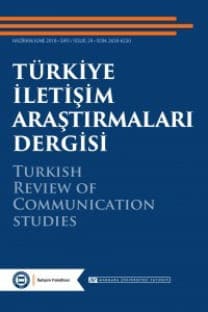Freud’dan Freud’a Aktarım: Psikanalitik Kuramın Netflix Dizisine Uyarlanması
Psikanalitik Teori, Sigmund Freud, Uyarlama, Netflix Dizisi, Televizyon Çalışmaları
Transposition from Freud to Freud: The Adaptation of Psychoanalytic Theory into a Netflix Series
Psychoanalytic Theory, Sigmund Freud, Adaptation, Netflix Series, Television Studies,
___
- Andrew, D. (1980). The well-worn muse: adaptation in film history and theory. In S. M. Conger, J. R. Welsch (Eds.), Narrative strategies original essays in film and prose fiction (pp. 9-17). Macomb: Western Illionois UP.
- Andrew, D. (2011). The economies of adaptation. In C. MacCabe, K. Murray, R. Warner (Eds.), True to spirit: Film adaptation and the question of fidelity (pp. 27-39). Oxford: Oxford UP.
- Bazin, A. (1966). Çağdaş sinemanın sorunları (N. Özön, Trans.). Ankara: Bilgi Yayınevi.
- Bazin, A. (1971). What is cinema? vol. II (H. Gray, Trans.). Los Angeles, London: University of California Press.
- Benjamin, W. (2002). The task of the translator. In M. Bullock & M. W. Jennings (Eds.), Selected Writings Volume I: 1913-1926 (pp.253-263). London: The Belknap Press of Harvard UP.
- Breger, L. (2012). Freud: Darkness and vision. Psychodynamic Psychiatry, 40 (2), 211-242. Doi:10.1521/ pdps.2012.40.2.211.
- Brooker, P. (2007). Postmodern adaptation: Pastiche, intertextuality and re-functioning. In D. Cartmell, I. Whelehan (Eds.), The Cambridge Companion to literature on Screen (pp. 107-120). Cambridge: Cambridge University Press.
- Casetti, F. (2004). Adaption and mis-adaptations: Film, literature, and social discourses. In D. Cartmell (Ed.), A companion to literature, film and adaption (pp. 81-91). London: Blackwell.
- Freud, S. (1936). The problem of anxiety (H. A. Bunker, Trans.). New York: Brown Press.
- Freud, S. (1989). Cinsel yasaklar ve normaldışı davranışlar (M. Sencer, Trans.). İstanbul: Ara Yayıncılık.
- Freud, S. (1993). Yaşamım ve psikanaliz (K. Şipal, Trans.). İstanbul: Say Yayınları.
- Freud, S. (2000). Psikanaliz üzerine (K. Şipal, Trans.). İstanbul: Cem Yayınevi.
- Freud, S. & Breuer J. (2001). Studies on hysteria (J. Strachey, Trans.). New York: Basic Books Inc., Publishers.
- Freud, S. (1962). Civilization and its discontents (J. Strachey, Trans.). New York: Norton Company.
- Freud, S. (2012). Narsizm üzerine ve Schreber vakası (B. Büyükkal & S. M. Tura, Trans.). İstanbul: Metis Yayınları.
- Geçtan, E. (1997). Psikodinamik psikiyatri ve normaldışı davranışlar. İstanbul: Remzi Kitabevi.
- Hand, R. J. (2012). Adaptation and modernism. In D. Cartmell (Ed.), A companion to literature film, and adaptation (pp. 52-70). Malden: Wiley-Blackwell.
- Hutcheon, L. (2006). A theory of adaption. New York: Routledge.
- Kranz, D. L. (2007). Trying harder: Probability, objectivity, and rationality in adaption studies. In J. M. Welsh & P. Lev (Eds.), The literature / film reader: issues of adaptation (pp. 77-104). Plymouth: Scarecrow Press.
- Kranz, D. L. & Mellerski, N. C. (2008). “Introduction.” In D. L. Kranz & N. C. Mellerski (Eds.), In/fidelity: Essays on film adaption. Newcastle: Cambridge Scholars Publishing.
- Kren, M. (Director). (2020 – ). Freud [TV Series]. Netflix Austrian-German: Bavaria Fiction, Satel Film, Mia Film.
- McFarlane, B. (1996). Novel to film: An introduction to the theory of adaption. Oxford: Clarendon Press.
- Muckenhoupt, M. (1997). Sigmund Freud explorer of the unconscious. New York, London: Oxford University Press.
- Özön, N. (1981). Sinema televizyon terimleri sözlüğü. Ankara: Türk Dil Kurumu Yayınları.
- Özön, N. (1984). 100 soruda sinema sanatı. İstanbul: Gerçek Yayınevi.
- Palmer, R. B. (2004). The sociological turn of adaption studies: The example of film noir. In R. Stam & A. Raengo (Eds.), A companion to literature and film (pp. 258-277). Oxford: Blackwell.
- Slethaug, G. E. (2014). Adaptation theory and criticism: Postmodern literature and cinema in the USA. London: Bloomsbury.
- Stam, R. (2005). Literature through film: Realism, magic and art of adaption. Londra, New York: Blackwell.
- Stam, R. & Raengo, A. (2005). Introduction: The theory and practice of adaption. In R. Stam & A. Raengo (Eds.), Literature and film: A guide to the theory and practice of film adaption (pp. 1-52). Malden, Oxford, Carlton: Blackwell Publishing.
- Başlangıç: 1992
- Yayıncı: Marmara Üniversitesi
Müşteri Sadakati Oluşturmada Mobil Uygulamaların Rolü: Nitel Bir Araştırma
Öykü ÇALYAN, İrem ELBİR, Elif EŞİYOK
Covid-19 Capslerinin Henri Bergson’un Gülme Teorisiyle Göstergebilimsel Analizi
Dijitalleşme Sürecinin Halkla İlişkiler Eğitimine Etkisi: Akademisyenler Üzerine Bir Araştırma
Murat KOÇYİĞİT, Büşra KÜÇÜKCİVİL
Doktorunuz Konuşuyor: COVID-19 Kamu Spotlarında Dizilerdeki Doktor Karakterlerin Temsili
COVID-19 Finansal Çalkantısı Sırasında Pandemi ile İlgili Haberlerin Borsa İstanbul’a Etkisi
Salgına Üstkurmaca Bakış: Veba Geceleri
Kamuların Durumsal Kuramı ile Segmentasyon: Türkiye Meme Kanseri Kamuları Örneği
Freud’dan Freud’a Aktarım: Psikanalitik Kuramın Netflix Dizisine Uyarlanması
